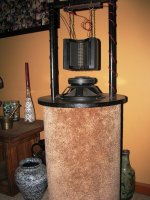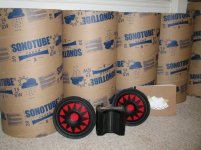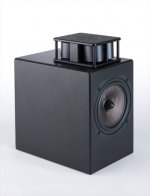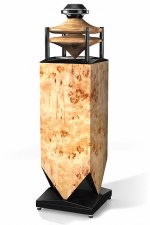Thanks for that Radugazon - I am aware of that thread from past years but it died off and I don't know if it was ever finished. Remarkable work - waaaaay above what I can do with my simple tools.
Thanks for that Radugazon - I am aware of that thread from past years but it died off and I don't know if it was ever finished. Remarkable work - waaaaay above what I can do with my simple tools.
As long as you have digital eq. and crossover you can "get away" with all sorts of radial designs.
The most basic is simply inverting a full-range driver (i.e. Walsh Driver method) and then eq.ing the response flat.
This would probably be a good driver for inversion due to it's extended rising response and very "open" basket:
https://www.madisound.com/store/product_info.php?cPath=45_241_308&products_id=9036
It would probably still need a radial super tweeter, but that could be accomplished with two compression tweeters facing each other with a small waveguide. I believe forum member CLS has an eminence super-tweeter with a similar set-up.
As freq.s go lower it's a LOT easier to implement.
Most designs are already "omni" at lower freq.s - and it really depends on the baffle and driver diameter. The smaller the driver and baffle, the higher the freq. for an "omni" pattern.
For something more sophisticated look to Dan's Soundrounds - which are mostly "omni" up to nearly 4 kHz:
http://www.htguide.com/forum/showthread.php4?t=28906
Last edited:
The most basic is simply inverting a full-range driver (i.e. Walsh Driver method) and then eq.ing the response flat.
Hi Scott - I've been there (and I'm still there) done that.....
Attachments
Hi Scott - I've been there (and I'm still there) done that.....
Cool!
I'd expect a woofer radial like that tops out at about 1.5 kHz (max), so most of the upper freq. response is dipole from the great Heil.
To get higher in freq. you generally need a smaller VC and a stronger motor that exhibits a "rising response".
There is also this tweeter:
hifi/stereo - ikonoklast tweeters
*way* to expensive for what it is, but still - it is unique.
Cool!
I'd expect a woofer radial like that tops out at about 1.5 kHz (max), so most of the upper freq. response is dipole from the great Heil.
Pioneer 10 inch - good to 6K - no longer available tho.
I'm thinking of going after something alone these lines Bella 5 - Products - High Emotion Audio along with a tapped horn for the lower stuff and a pro 6 inch driver with PR on the back side of da box. Probably start out with an Eminence 6 Eminence Alpha-6A 6" Midrange 8 Ohm or something of the sort. I would still use the AMT1's for the high stuff but I prefer to cross them pretty high up.
I would luv to get my hands on a pair of the tweeters High Emotion Audio is using. I got to listen to a set of bella 7's and it is a very nice speaker.
They are made here in Nashville and I know a guy that knows a guy that sez he will see if something can get worked out. I'm not holding my breath about that tho.....
Attachments
The Bella 5 looks like it uses a variant of a linaeum tweeter. You can see the measurements of the original tweeter here:
RadioShack Optimus Pro LX5 loudspeaker Measurements | Stereophile.com
The horizontal pattern is not at all uniform in intensity.
RadioShack Optimus Pro LX5 loudspeaker Measurements | Stereophile.com
The horizontal pattern is not at all uniform in intensity.
The Bella 5 looks like it uses a variant of a linaeum tweeter. You can see the measurements of the original tweeter here:
RadioShack Optimus Pro LX5 loudspeaker Measurements | Stereophile.com
The horizontal pattern is not at all uniform in intensity.
It is in fact an updated linaeum tweeter - High Emotion Audio purchased the rights to the linaeum driver and then added some improvement - which they have patents on - Patent WO/2007/079441A2
In this article the writer - Scott Wilkinson - mentions the use of a new linaeum driver - Let There Be LET | Ultimateavmag.com
After hearing it for about 5 or 6 hours I can state that it is one heck of a driver. Good horizontal dispersion but vertical dispersion needs to be paid attention to.......
Here is the Wharfdale Teesdale from the 1960's incorporating omni principles in the design.
I recently acquired a pair of these and have restored the crossovers and potentiometers. Sound very good for their vintage.
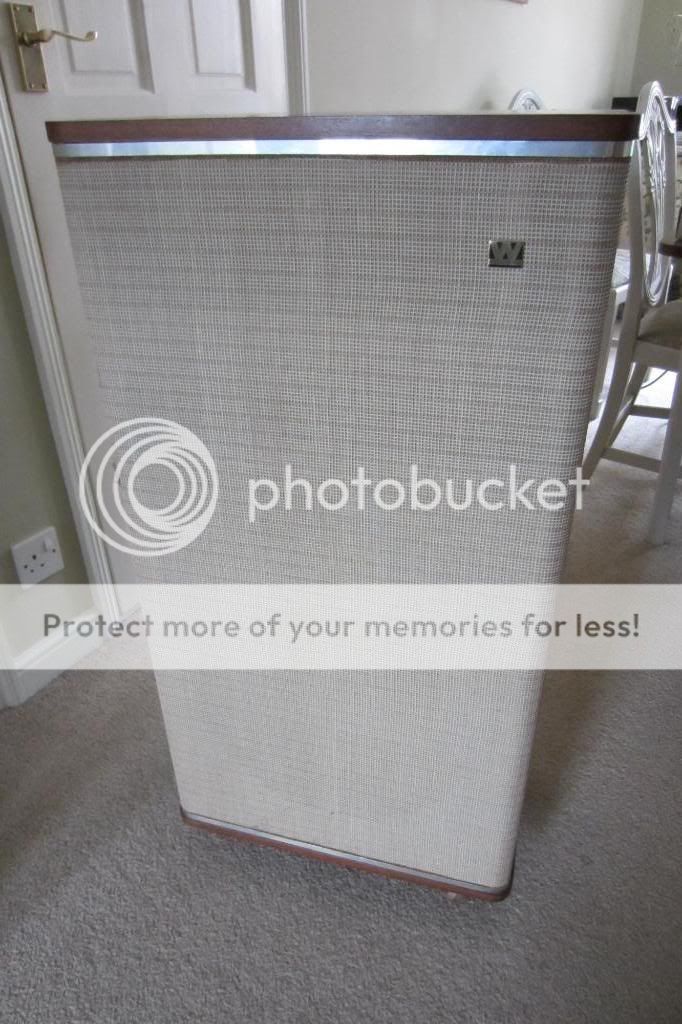
Inside the cab, viewed from the back. Omni reflectors clearly visible. The mid and tweeter point upwards into these. The cabinet is open on the front and sides to allow radiation in these directions.

There are very few pictures around of these speakers, so i add these just for the record:

Crossover before restoration:

After restoration with Alcaps and 50 ohm wirewound pots internally cleaned with Deoxit:

Front firing 15" bass driver:

They are incidentally available to anyone who wants to give them a good home!
I recently acquired a pair of these and have restored the crossovers and potentiometers. Sound very good for their vintage.

Inside the cab, viewed from the back. Omni reflectors clearly visible. The mid and tweeter point upwards into these. The cabinet is open on the front and sides to allow radiation in these directions.

There are very few pictures around of these speakers, so i add these just for the record:

Crossover before restoration:

After restoration with Alcaps and 50 ohm wirewound pots internally cleaned with Deoxit:

Front firing 15" bass driver:

They are incidentally available to anyone who wants to give them a good home!
I thought this statement might be interesting:
"The upfiring model has the same bass inadequacy which could easily be compensated with a pair of subwoofers. Ambience is the real killer. The atmospheric presence is so airy and natural that it transcends hifi to a musical illusion that can be linked only to live concerts. It breaks all the laws of hifi attributes. It makes me wonder whether performer localization we’ve treasured so much might have grown too pin-point sharp to remain real. Hifi layering is probably too well defined which has different instrumental groups sound like flat panels or detached strata. If you are prepared to trade in hifi attributes for pure musical aura and local analysis for global coherence, energy and density for spontaneity and relaxation, this is for you."
6moons audio reviews: Polking fun at DIY speakers
"The upfiring model has the same bass inadequacy which could easily be compensated with a pair of subwoofers. Ambience is the real killer. The atmospheric presence is so airy and natural that it transcends hifi to a musical illusion that can be linked only to live concerts. It breaks all the laws of hifi attributes. It makes me wonder whether performer localization we’ve treasured so much might have grown too pin-point sharp to remain real. Hifi layering is probably too well defined which has different instrumental groups sound like flat panels or detached strata. If you are prepared to trade in hifi attributes for pure musical aura and local analysis for global coherence, energy and density for spontaneity and relaxation, this is for you."
6moons audio reviews: Polking fun at DIY speakers
Interesting and for classical music recordings probably exactly the right solution but it simply doesn't work well with 99% of all other recordings. Multitrack recording and mixing in acoustically controlled control rooms has created an art form of its own over the last decades.
An ideal reproduction chain should be able to recreate both aural spaces. I'm currently experimenting with a single center speaker and virtual reflections coming from additional speakers. It's pretty easy to create spacious sound but it's also easy to loose intelligibility and transparency.
Interesting and for classical music recordings probably exactly the right solution but it simply doesn't work well with 99% of all other recordings.
Multitrack recording and mixing in acoustically controlled control rooms has created an art form of its own over the last decades.
An ideal reproduction chain should be able to recreate both aural spaces.
I'm currently experimenting with a single center speaker and virtual reflections coming from additional speakers. It's pretty easy to create spacious sound but it's also easy to loose intelligibility and transparency.
My conclusions were somewhat different. I personally don't perceive a huge difference from a good radial mid design vs a good "forward" mid design, and where I do perceive that difference it's nearly all to the benefit of the radial mid. (..max sound pressure level is the most significant exception, with the radial "down" by almost 9 db in comparison to the forward mid. ..application dependent.)
The real differences I'd attribute to the emission surface area, how it bounds to the driver/baffle, and listener distance in relation to that emission.
Get further away from the loudspeakers and it becomes more "pin-point" (..though getting further away increases reflective combing and as a result image occlusion - sort of a two steps forward, one step back with respect to localization.) Of course getting further away also decreases stage width, how compelling the playback is, etc.. So it's probably more like "2 steps forward 5 or 6 steps back".
For me this is all irrespective of the media mix. (..and most of the stuff I listen to is multi-track.)
In any event, the article was a decent exploration into subjective preference for various designs.. but I can't help but wish more detail was presented. For instance varying differences between the dome tweeter forward firing vs. various angles approaching a full radial (or laying "flat"). (..and obviously some accompaniment of graphical freq. responses on-and off-axis.)
Last edited:
I personally don't perceive a huge difference from a good radial mid design vs a good "forward" mid design
What does your room and setup look like? Did you have the chance to A/B those different designs?
What does your room and setup look like? Did you have the chance to A/B those different designs?
The room size changed over the years of experimentation, but I don't think any were smaller than 14 by 12 (feet), and several were much larger.
On several occasions I "A/B"ed the experiment, and even on a few I had someone else doing the switching.
The experiments also changed, but were for the most part radial mid.s - some extending to almost 2 kHz. I did some limited trials of reflective "waveguides" on both mids and tweeters, and rarely like the results - to "diffuse" subjectively (though the tweeter "waveguide" experiments worked a LOT better than the "waveguide" mid.s).
For the most part the smaller the radial mid., the higher the upper freq. response extended and the better the effect. Like the article writer, I also ended up trying several types of ceiling speakers, though I preferred the "full-range" variety as mid.s. Unlike the writer however I was also using measuring equipment in my designs (..loudspeakerlab).
Anyway, that was a while ago. (..the final mid I had settled on was the Altec CF404-8A, not great.. but not to bad either - and certainly cheap enough for experimentation.)
Hi Y'all,
This has been an educational thread to follow, indeed. Only, there seems to be a strong tendency to veer off into the direction of Linaeum tweeters, Heil drivers, flooders, dipoles and combinations of dipole with upside down cone drivers. Are those really omnidirectional? Do they really do the same thing as e.g.: a true Walsh driver? When I posted the Ohm A in Post #52 I was admonished with: "...not quite. Not omnidirectional in the vertical...". So all these dipoles, flooders and radials(?) are more omnidirectional than a Ohm-A?
Since then the thread has covered a gamut of interesting subjects, and rarely returned to the subject of omnidirectional speakers, not to talk about the most important point Scottmoose sighed about in Post #55: "...this means the end results are more heavily dependant upon the acoustic environment, and its absorptions, reflections...".
I feel Scottmoose touched a soft spot there, and I think the most important point "Why OMNI speakers are not more popular" is: most people do not want to do the work necessary to get the room and the speakers aligned with each other and the listening area. I have never understood how someone can dedicate endless hours to the design and construction of the "ultimate" loudspeaker, and be totally oblivious as to why e.g.: a 0.4sec RT60 is desirable, and how it can be achieved in a normal listening room. And it doesn't realy make much of a difference what type of loudspeakers you are trying to integrate into the room, but it is imperative with an omnidirectional setup. I would like to suggest this link:
RT60 - Reverberation Time | Acoustic Frontiers.
A good general point of reference, and it would also be important to distribute the resulting reflective and absorptive surfaces more or less evenly throughout the room. Then you can start on speaker placement, and work the speakers and the decor back and forth until you actually have a listening area (not some infinitesimally small "golden" spot.
I actually spent quite a few joyful hours with a pair of Ohm-As powered by a Mc 2300, there was an overall realism and spaciousness in the sound field that I have not experienced since. In the end I preferred my home-build JBLs (D130 / LE75 on custom fiberglass Altec 801 copies / JBL 077 Slot Radiators) they just had a dynamic presentation the Ohm-As couldn't touch (see: Beranek's Law). Maybe the Duevels (e.g.: Diamante) can combine the spaciousness of the Ohm As with the crispness of the JBLs. Sadly, I never had the opportunity to hear them, maybe someone who auditioned them can share his opinion?
Regards,
This has been an educational thread to follow, indeed. Only, there seems to be a strong tendency to veer off into the direction of Linaeum tweeters, Heil drivers, flooders, dipoles and combinations of dipole with upside down cone drivers. Are those really omnidirectional? Do they really do the same thing as e.g.: a true Walsh driver? When I posted the Ohm A in Post #52 I was admonished with: "...not quite. Not omnidirectional in the vertical...". So all these dipoles, flooders and radials(?) are more omnidirectional than a Ohm-A?
Since then the thread has covered a gamut of interesting subjects, and rarely returned to the subject of omnidirectional speakers, not to talk about the most important point Scottmoose sighed about in Post #55: "...this means the end results are more heavily dependant upon the acoustic environment, and its absorptions, reflections...".
I feel Scottmoose touched a soft spot there, and I think the most important point "Why OMNI speakers are not more popular" is: most people do not want to do the work necessary to get the room and the speakers aligned with each other and the listening area. I have never understood how someone can dedicate endless hours to the design and construction of the "ultimate" loudspeaker, and be totally oblivious as to why e.g.: a 0.4sec RT60 is desirable, and how it can be achieved in a normal listening room. And it doesn't realy make much of a difference what type of loudspeakers you are trying to integrate into the room, but it is imperative with an omnidirectional setup. I would like to suggest this link:
RT60 - Reverberation Time | Acoustic Frontiers.
A good general point of reference, and it would also be important to distribute the resulting reflective and absorptive surfaces more or less evenly throughout the room. Then you can start on speaker placement, and work the speakers and the decor back and forth until you actually have a listening area (not some infinitesimally small "golden" spot.
I actually spent quite a few joyful hours with a pair of Ohm-As powered by a Mc 2300, there was an overall realism and spaciousness in the sound field that I have not experienced since. In the end I preferred my home-build JBLs (D130 / LE75 on custom fiberglass Altec 801 copies / JBL 077 Slot Radiators) they just had a dynamic presentation the Ohm-As couldn't touch (see: Beranek's Law). Maybe the Duevels (e.g.: Diamante) can combine the spaciousness of the Ohm As with the crispness of the JBLs. Sadly, I never had the opportunity to hear them, maybe someone who auditioned them can share his opinion?
Regards,
Attachments
A true fullrange omni is nothing more than a myth.. Acoustic center derived from one point where it expands outward in all directions fullrange. Even a very limited bandwidth driver like a plasma high freq. driver is not completely omni - though it comes about as close as you can get.
For the most part then that leaves "omni" as *radial*, or 360 degrees horizontal. Even then a lot of designs won't meet that constraint.
..and in my experience this:
"...this means the end results are more heavily dependant upon the acoustic environment, and its absorptions, reflections..."
-is wrong. (..which isn't to say that there are no effects, rather that they aren't so hugely determinative as others would argue - at least not above the modal region.)
On the other hand like you I fully agree that walsh designs are decidedly lacking in dynamics and overall output.
BTW, out of curiosity - did you find that for most recordings that a spread of 7 to 8 feet between speakers (walsh-type) was mostly optimal?
For the most part then that leaves "omni" as *radial*, or 360 degrees horizontal. Even then a lot of designs won't meet that constraint.
..and in my experience this:
"...this means the end results are more heavily dependant upon the acoustic environment, and its absorptions, reflections..."
-is wrong. (..which isn't to say that there are no effects, rather that they aren't so hugely determinative as others would argue - at least not above the modal region.)
On the other hand like you I fully agree that walsh designs are decidedly lacking in dynamics and overall output.
BTW, out of curiosity - did you find that for most recordings that a spread of 7 to 8 feet between speakers (walsh-type) was mostly optimal?
mids
But why only mids? I found that higher frequencies can overrule anything. The speaker can be placed lower and reflections coming from higher angles will lift sources. This happens when reflections are -5dB from the direct sound or louder.
I think there's more to it than what RT60 reveals. The arrival time of first reflections needs to be controlled. Otherwise one ends up with muddy sounds - spacious but muddy. Later reflections should be very low in level.
On the other hand I suspect part of the secret sauce of omnis is that they are sound sources within a certain room the listener is already aurally adapted to. He or she doesn't need to re-adapt to an acoustically optimized sweetspot.
Maybe the Duevels (e.g.: Diamante) can combine the spaciousness of the Ohm As with the crispness of the JBLs.
Has anybody every tried to create a half-omni? All that energy radiated towards the front wall seems counterproductive to me.
Omnidirectional speakers can be achieved by glueing sound absorbing foam to the baffle,whitch ,the speakerbaffle ,that is ,has been made so small as can possible be.Attached to the woodenbaffle,that is made as small as the speaker. The overall frequentiecharacteristics smooth out a little bit ,transient respons gets better and pollar patterns get better as well ,more around the loudspeaker .This last one is clearly hearable by walking round about the speaker and listen if there is a high freq. decrease.Offcourse is the round about sound only percievable at high frequentie cause there diffraction and interference is the major problem.The lower the frequentie gets,the more it gets omnidirectional,source;journal of the audio engeneering society
Post #275
Hi ScottG:
"...did you find that for most recordings that a spread of 7 to 8 feet between speakers (walsh-type) was mostly optimal?"
I only had them for a few days in only one room (besides a show room where they were not so great), so I don't have much of an opinion on that subject. As to spacing: it's a long time ago, my guess would be that they ended up about 7-10ft apart, centered 2-3ft from the front wall (pretty close) and 3-4ft from the side walls. They probably needed a larger room, but did work quite nicely. They did need a lot of amplifier to come alive.
Anyway, just something I foundly remember. I would recommend playing around with omnis, and other forms of direct reflecting loudspeakers. Just don't forget the room.
Post #277
Hi markus76,
Yes, there is, "...more to it than what RT60 reveals. The arrival time of first reflections needs to be controlled...". I was surprised, that the Ohm-As did not want to play nice when too far away from the front and side walls in the room I had them in, maybe with more time I could have found a better positioning.
"...I suspect part of the secret sauce of omnis is that they are sound sources within a certain room the listener is already aurally adapted to. He or she doesn't need to re-adapt..." Very interesting thought, may well be the case. But, don't we readapt continuously to all kinds of environments? I remember the wider sound stage from the Ohm-As made them easy to listen to.
Regards,
Hi ScottG:
"...did you find that for most recordings that a spread of 7 to 8 feet between speakers (walsh-type) was mostly optimal?"
I only had them for a few days in only one room (besides a show room where they were not so great), so I don't have much of an opinion on that subject. As to spacing: it's a long time ago, my guess would be that they ended up about 7-10ft apart, centered 2-3ft from the front wall (pretty close) and 3-4ft from the side walls. They probably needed a larger room, but did work quite nicely. They did need a lot of amplifier to come alive.
Anyway, just something I foundly remember. I would recommend playing around with omnis, and other forms of direct reflecting loudspeakers. Just don't forget the room.
Post #277
Hi markus76,
Yes, there is, "...more to it than what RT60 reveals. The arrival time of first reflections needs to be controlled...". I was surprised, that the Ohm-As did not want to play nice when too far away from the front and side walls in the room I had them in, maybe with more time I could have found a better positioning.
"...I suspect part of the secret sauce of omnis is that they are sound sources within a certain room the listener is already aurally adapted to. He or she doesn't need to re-adapt..." Very interesting thought, may well be the case. But, don't we readapt continuously to all kinds of environments? I remember the wider sound stage from the Ohm-As made them easy to listen to.
Regards,
- Home
- Loudspeakers
- Multi-Way
- Why are OMNI speakers not more popular?
